The 2021 MAA Design Award celebrates the work of the Fellow Members of the Millinery Association of Australia. The theme for this year’s award was The 20’s – Past, Present, Future.
Judging criteria for the competition included originality and creativity, relevance to the era, quality of workmanship, degree of difficulty and wearability in terms of comfort and stability. The panel included Lauren Ritchie, President of the Millinery Association of Australia and Editor of The Hat Magazine, Lorraine Gill, TAFE SA Lecturer and Anna Vlach, Fashion Editor of the Adelaide Advertiser.
1st Place – Georgia Skelton Millinery
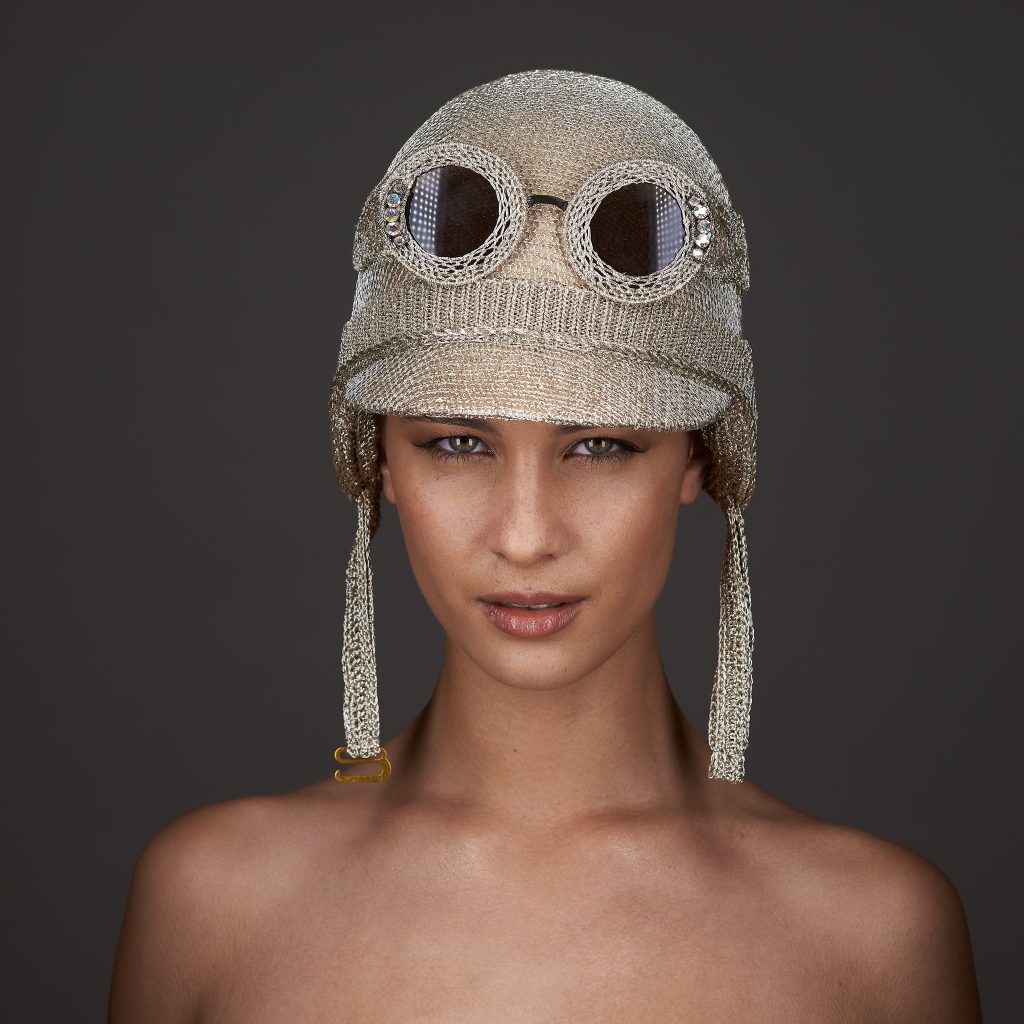
Georgia Skelton ‘Fantasy Flight’
This is my take on the Aviator hat dating from the 1920’s and I’ve updated it for a modern winter race event for the 2020’s. Aviator hats became popular in the early days of the 20th century as open-cockpit airplanes took to the skies. Pilots needed a hat to keep their head and ears warm, as well as goggles to protect their eyes whilst airborne. Aviator hats have since continued as a popular fashion accessory and winter hat choice through the decades.
2nd Place – Peacock Millinery
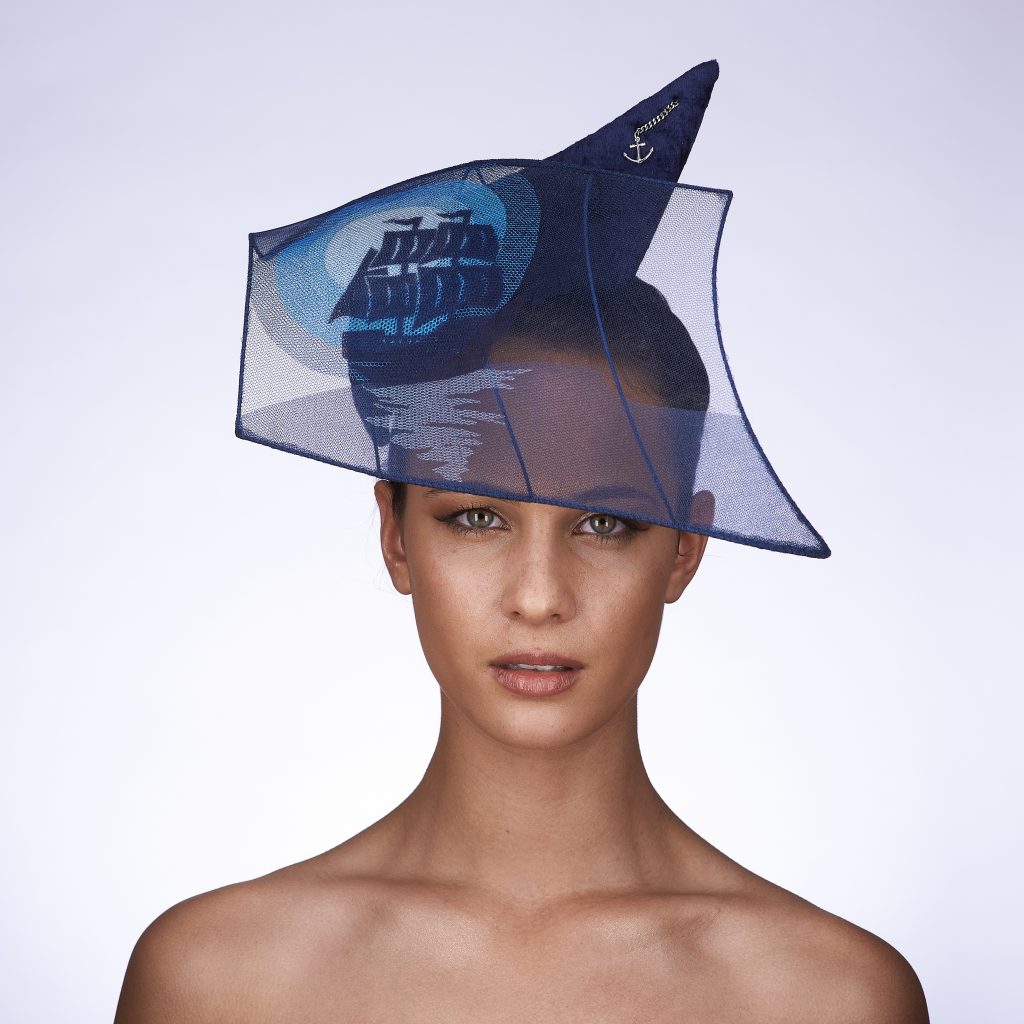
Belinda Osborne ‘Mayflower 1620’
The Mayflower was the ship that took the Pilgrims to the New World in 1620. I wanted to create a contemporary piece that reflected this historical event. The blocked shape represents the ship and the wirework and tulle the ship’s sails and the story of the journey, with the Mayflower sailing on the ocean by moonlight.
3rd Place – Rachel Henry Millinery
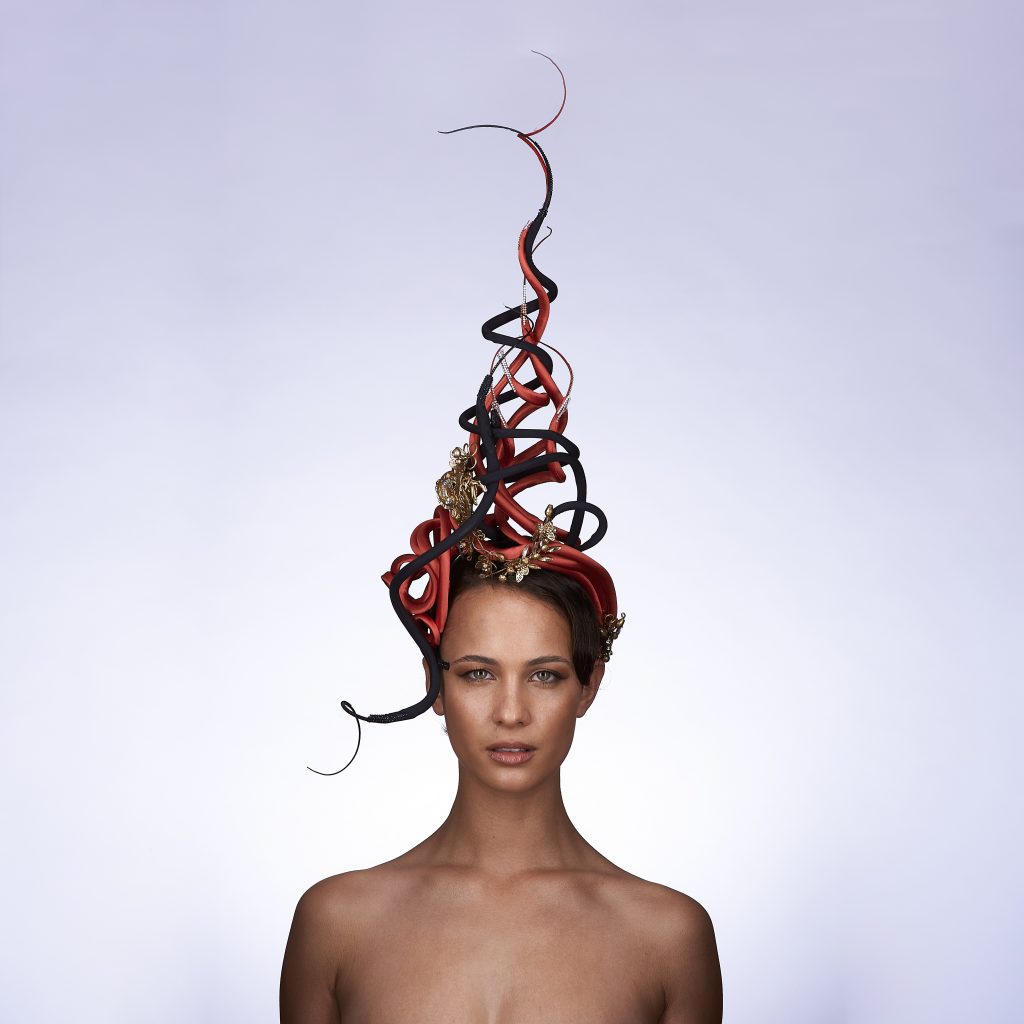
Rachel Henry ‘Love Letter to a Myth’
My inspiration is from the year I was 20. The year 1997 saw the tragic death of fashion icon Gianni Versace. He was famous for his brazen defiance of fashion rules but was equal to combined luxurious classicism with overt sexuality. My piece is a modern millinery interpretation of the Versace logo, Head of Medusa, complete with Italian gold embellishments. Versace chose Medusa because she made people fall in love with her and they had no way back. He hoped that this would be the same for his brand.
Patron’s Pick selected by Stephen Jones
Georgia Skelton

Stephen’s comments: Very interesting knit and he would love to see someone at the races wearing this piece as it would get everyone’s attention. He thought it was original, fun and well made
People’s Choice – Hat’s By Tracy Mac
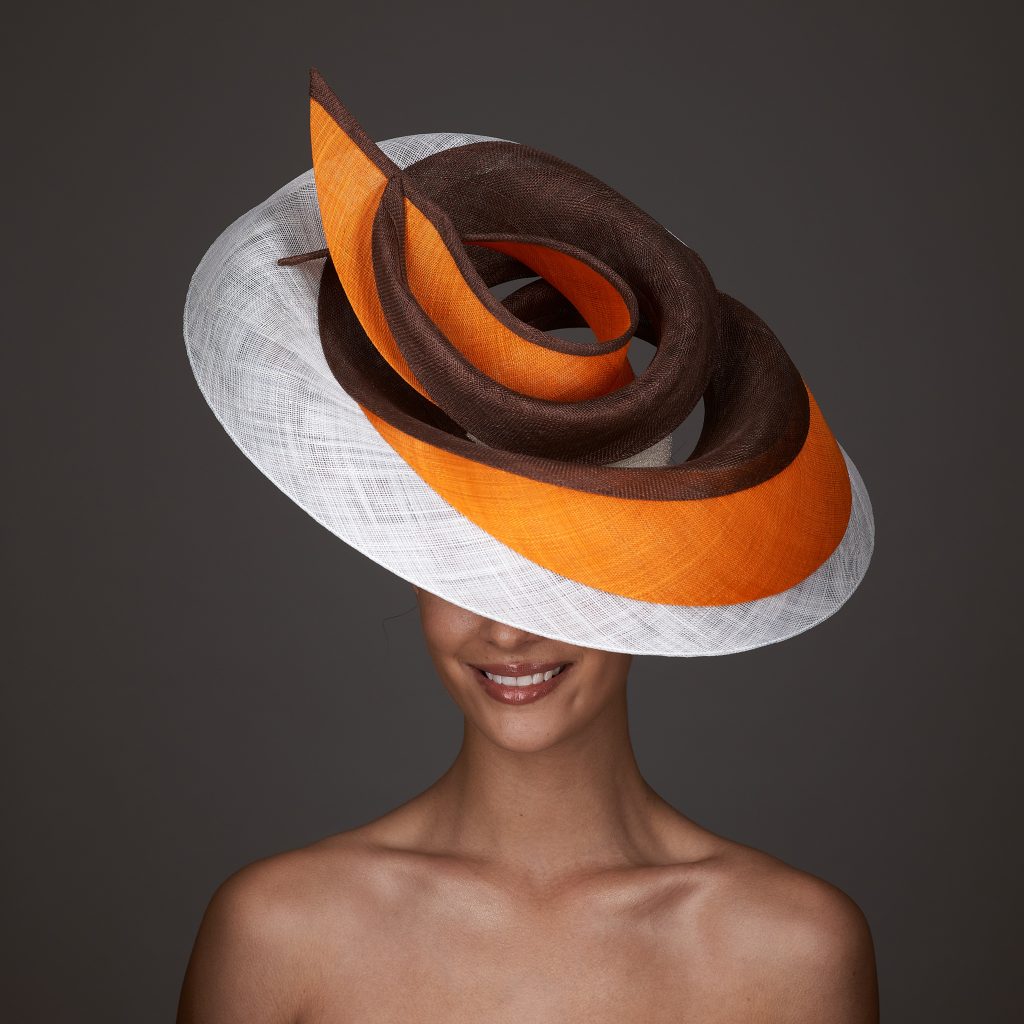
The piece is made using a technique I recently learned. One of my main mottos in life is that you never stop learning. So my piece is from the present era with a touch of 70’s colour combinations.
Top 10
Karen Bailey Millinery
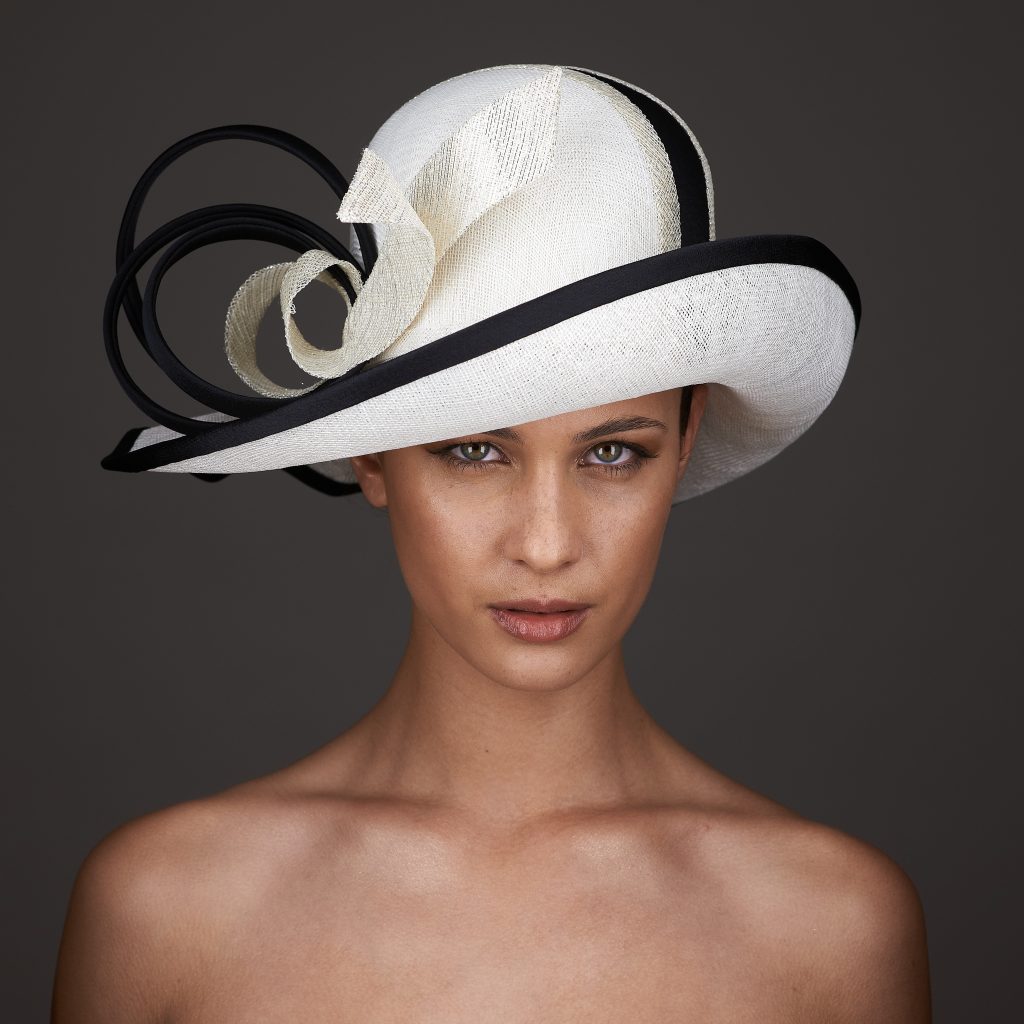
Karen Bailey ‘The Chrysler Hat’
My inspiration came from the Chrysler Building built in New York city in 1928. The flared brim reflects the radiator inspired eagle gargoyles on the corners of the building and the building’s Art Deco elevator doors inspired the fan and scroll detail on the hat’s crown and trim. White and silver sinamay was chosen for the hat’s construction to reflect the white bricks used on the exterior of the building.
Catherine Storm Millinery
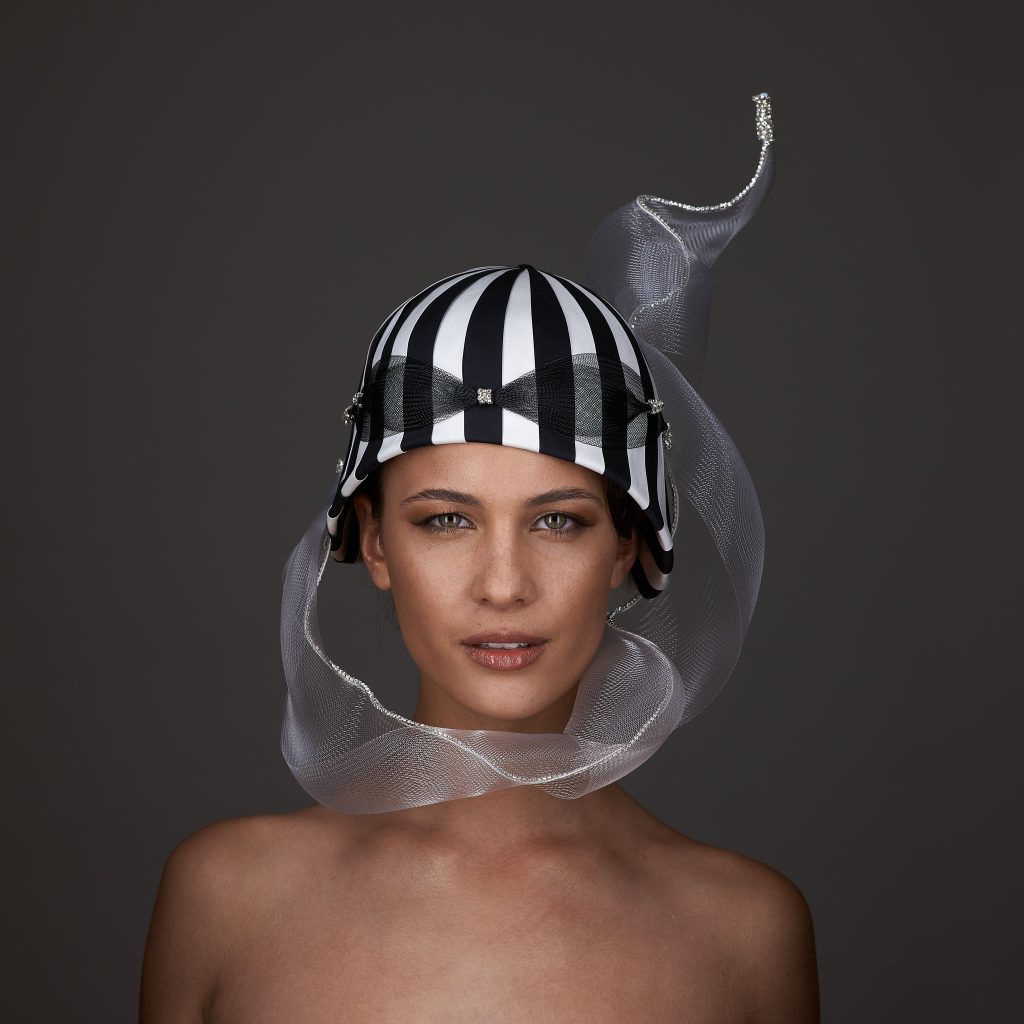
Catherine Storm ‘Aviatrix’
Inspired by the daring and adventurous female aviators of the 1920’s. The cloche-like shape recalls a flying helmet. Black and white pleated silk form an art deco inspired motif that is suggestive of a spinning propellor. Black crinoline has been fashioned into a pair of flying goggles and wired clear crinoline, trimmed with rhinestones, creates a flying scarf.
Patron’s Special Mention select by Stephen Jones
Bonnetry Millinery
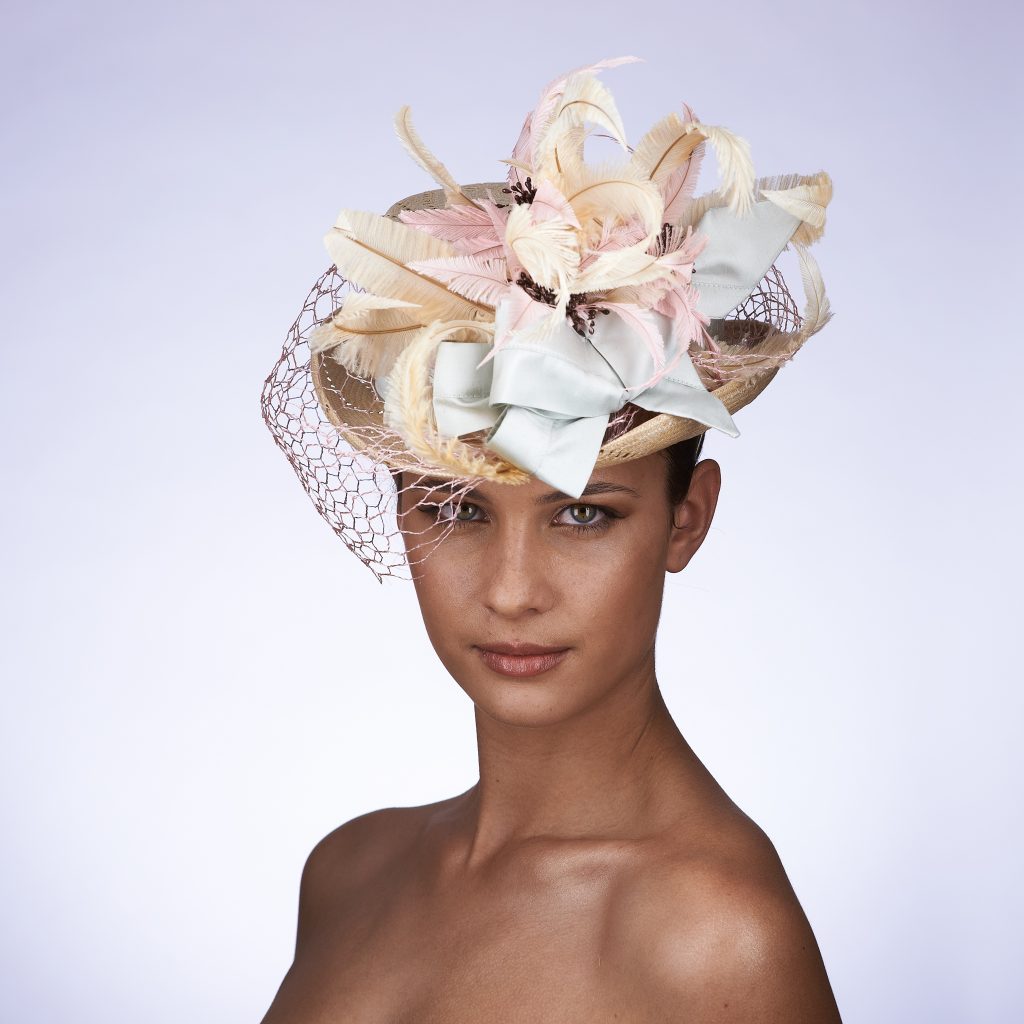
Jo Honan ‘Miss Bennet’s Riding Hat’
I am an avid reader and my design was influenced by Jane Austen’s novel ‘Pride and Prejudice’. The varied descriptions of clothing and the pursuits undertaken by women in the 1820’s Regency period had me thinking about their hats a lot! The Riding hat is my favourite as it’s a practical hat with the capacity for ornamentation as great, or as little, as desired. And it is so ultimately wearable.
Louise Macdonald Milliner
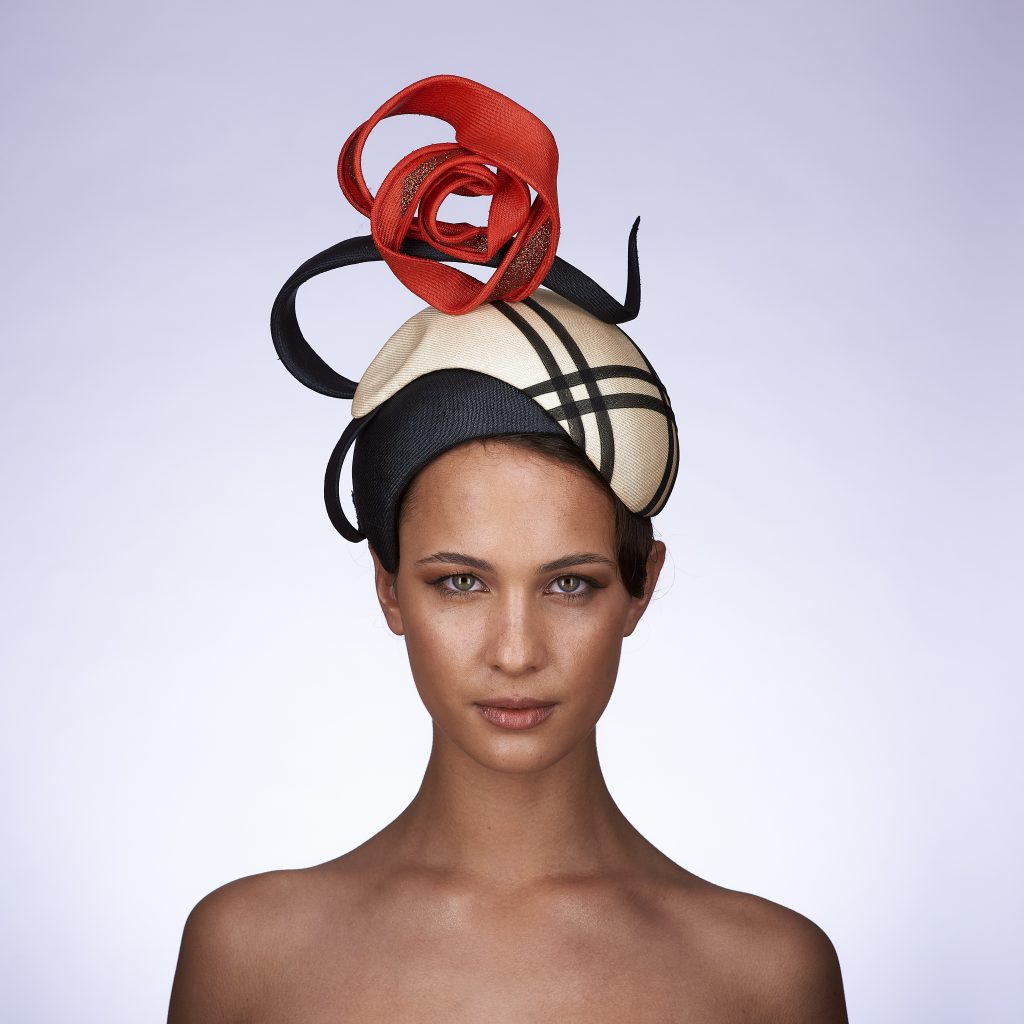
Louise Macdonald ‘The Mackintosh Rose’
Three elements connect with the 20’s theme for me.
1. In the 1920’s, stylised flowers like the Mackintosh Rose were common motifs In textiles, clothing and interior furnishings. The red stylised flower in my headpiece and black lines are inspired by designer and architect Charles Rennie Mackintosh, who influenced this trend in the early 1900’s and 1920’s.
2. Sustainability in fashion is forefront in our minds in the 2020’s. The straws I have used are recycled from old hats I found at a garage sale about 15 years ago. Squashed, broken and sun damaged, I pulled apart the hats and bought them back to life in a new shape and design.
3. The finely woven paribuntal straw I have used is no longer manufactured. However, it was a common material used to make cloches in the 1920’s.
Contempromental
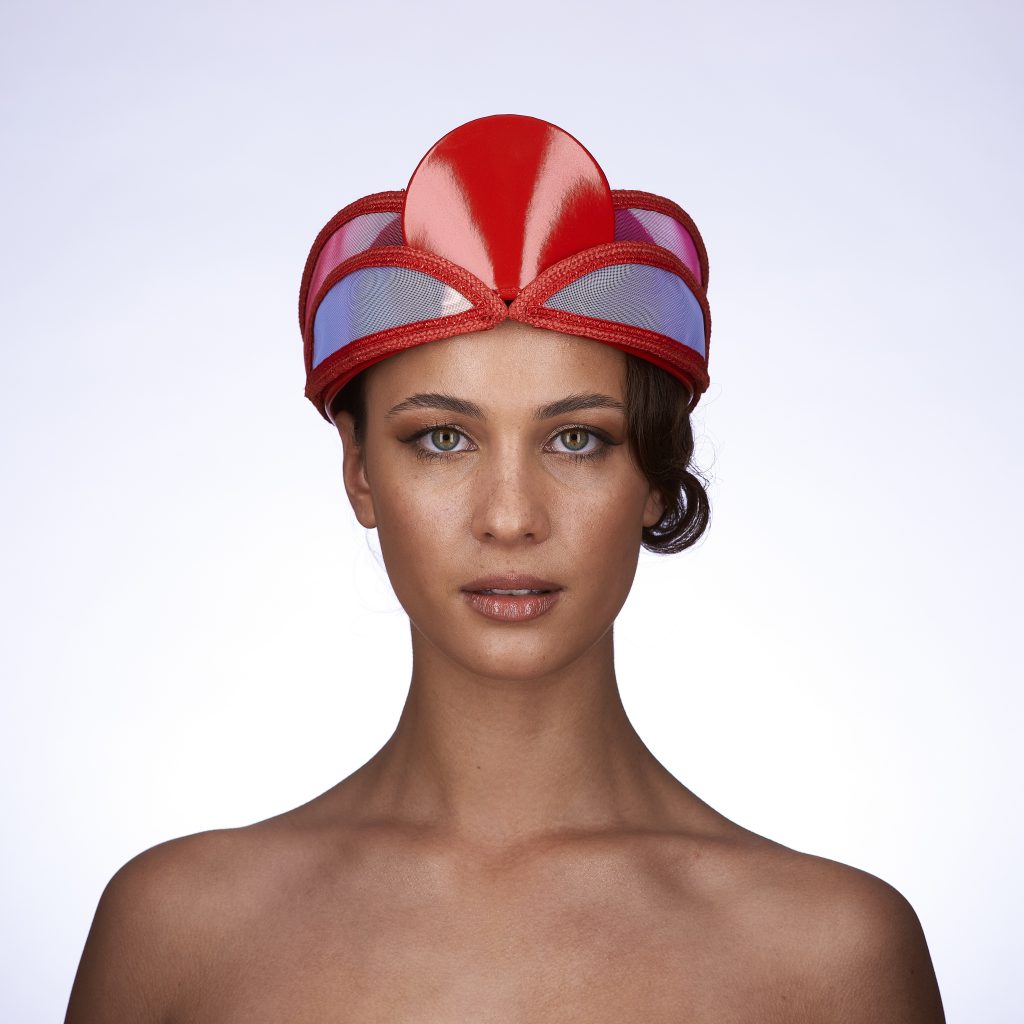
Laura Dunnington ‘Future Flapper’
This headpiece is a celebration of the Flapper mentality of the 1920’s which was all about breaking free of societal expectations and living life free of restrictions. This theme seems pertinent in today’s society where we continue to challenge preconceived ideas of gender, sexuality and ‘social norms’.
Patron’s Special Mention select by Stephen Jones
Lisa Hughes Millinery
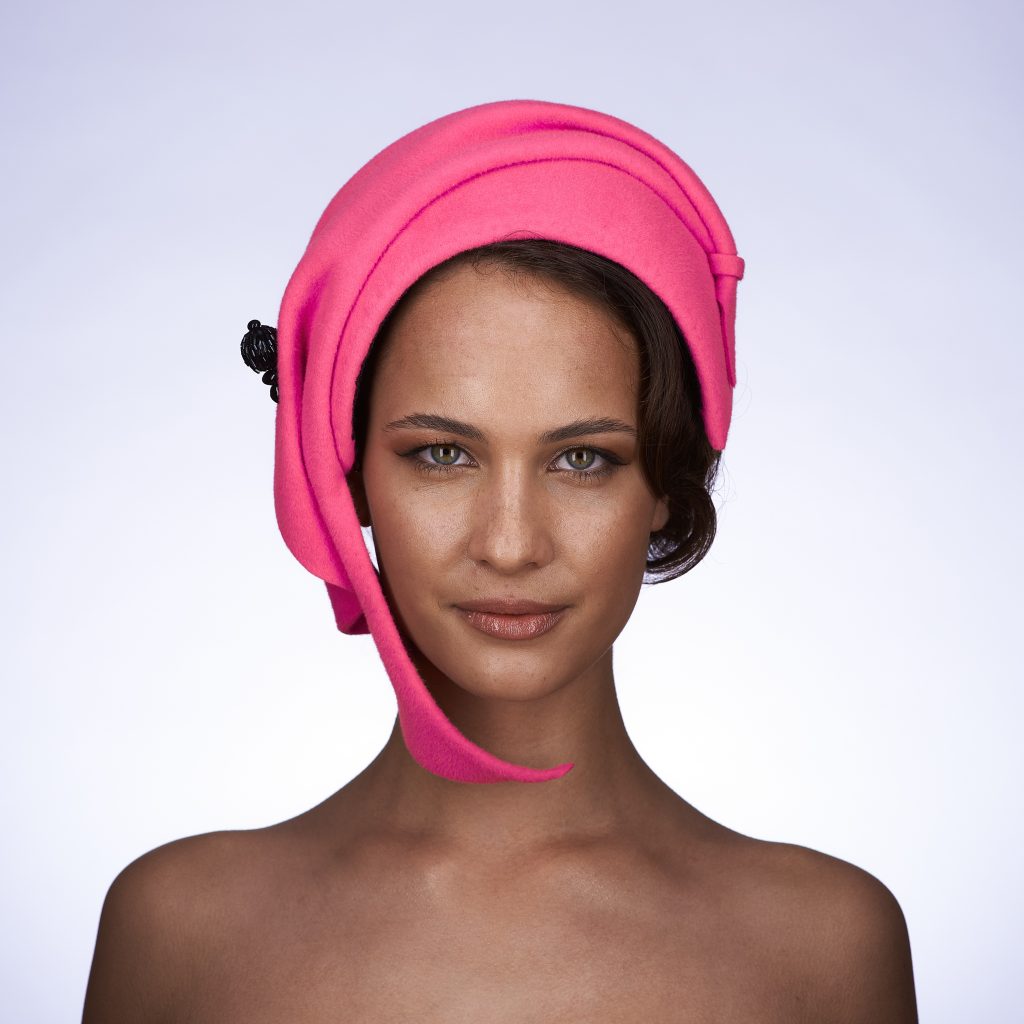
Lisa Watt ‘In the Pink’
I almost didn’t enter this year because inspiration didn’t come easily, even though I had over a year to research the 20’s theme! I often get caught up over thinking competition pieces and second guessing which direction to take. After deliberating for so long the revelation came to me when I rediscovered a candy pink fur felt capeline in my stash. I was instantly inspired to infuse a 1920’s aesthetic into a wearable design for the modern hat lover. The felt had such a beautiful drape so I wanted to celebrate a piece that hopefully makes you smile.
Jo Maree Millinery
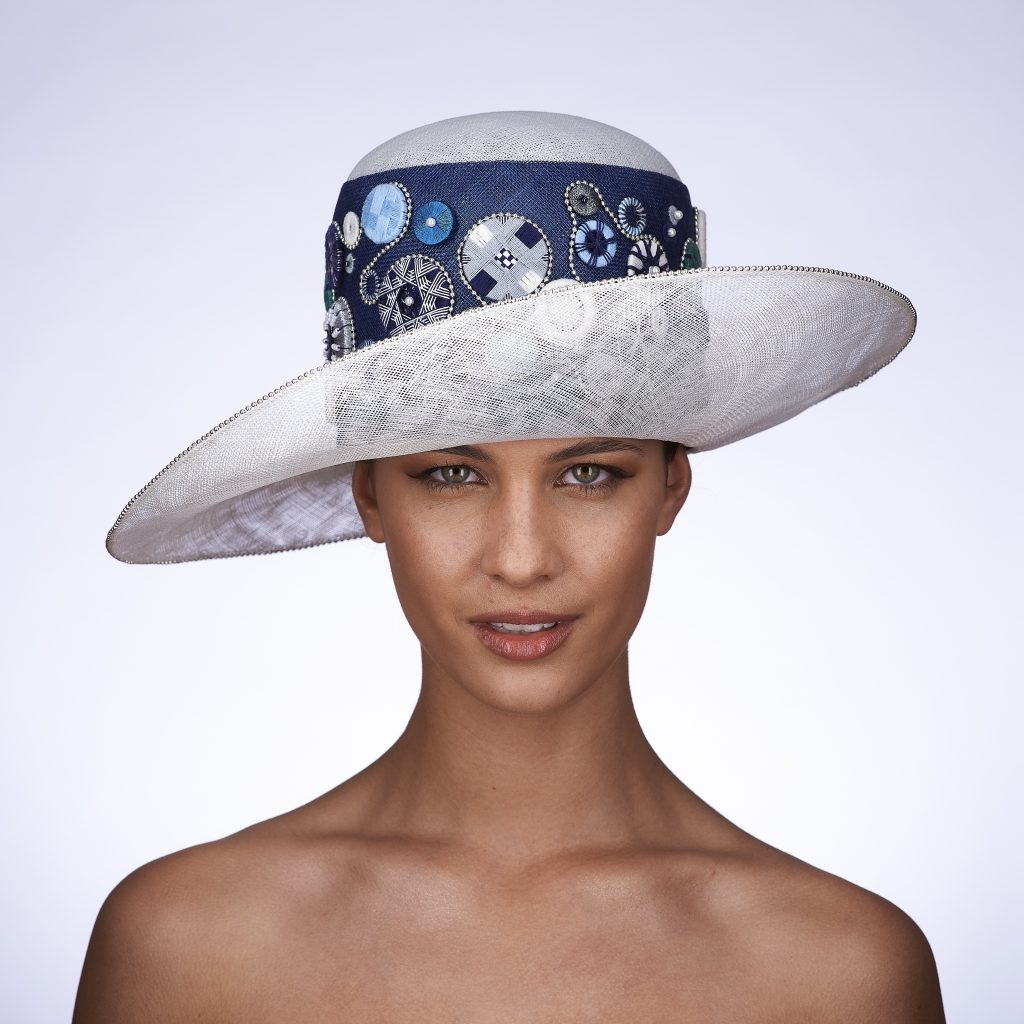
Jo Peterson ‘Blue Ice’
My entry has a gentle nod to the 1920’s iconic cloche hat but this was really just a vessel for the trim as it was always all about the buttons. I recently discovered the world of beautiful handmade Dorset buttons and knew that this was the ‘twenties’ era I wanted to focus on for my Design Award entry. Dorset Buttons originated in Shaftesbury, England and became a major cottage industry in the 1620’s creating employment and income for thousands of women and children. Each button used a slice of Dorset ram horn as the outer button shape which would then be embroidered with locally made linen yarns and fabric to create the finished piece. Early examples of Dorset buttons include Crosswheel, Death’s Head and Shirtlace and these, taking several hours each to make, feature as the main design element of my entry.
Kathleen’s Creative Millinery
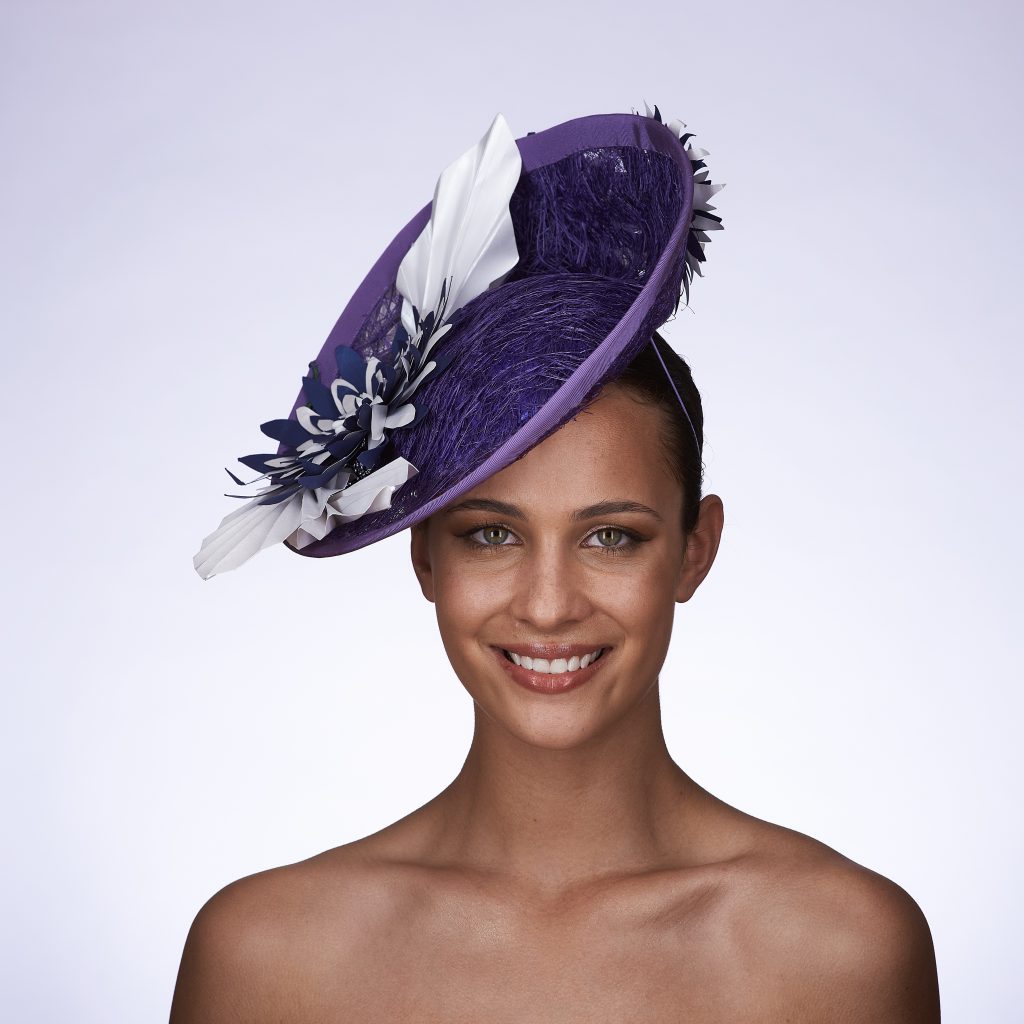
Kathleen Watson
Future millinery will use new innovative materials. I’m inspired by these materials. The colour purple is associated with royalty, nobility, luxury, power and ambition with the meaning of wealth, extravagance, creativity, dignity, grandeur, mystery, independence and magic which to me means millinery throughout all the ages.
Leteisha’s Millinery
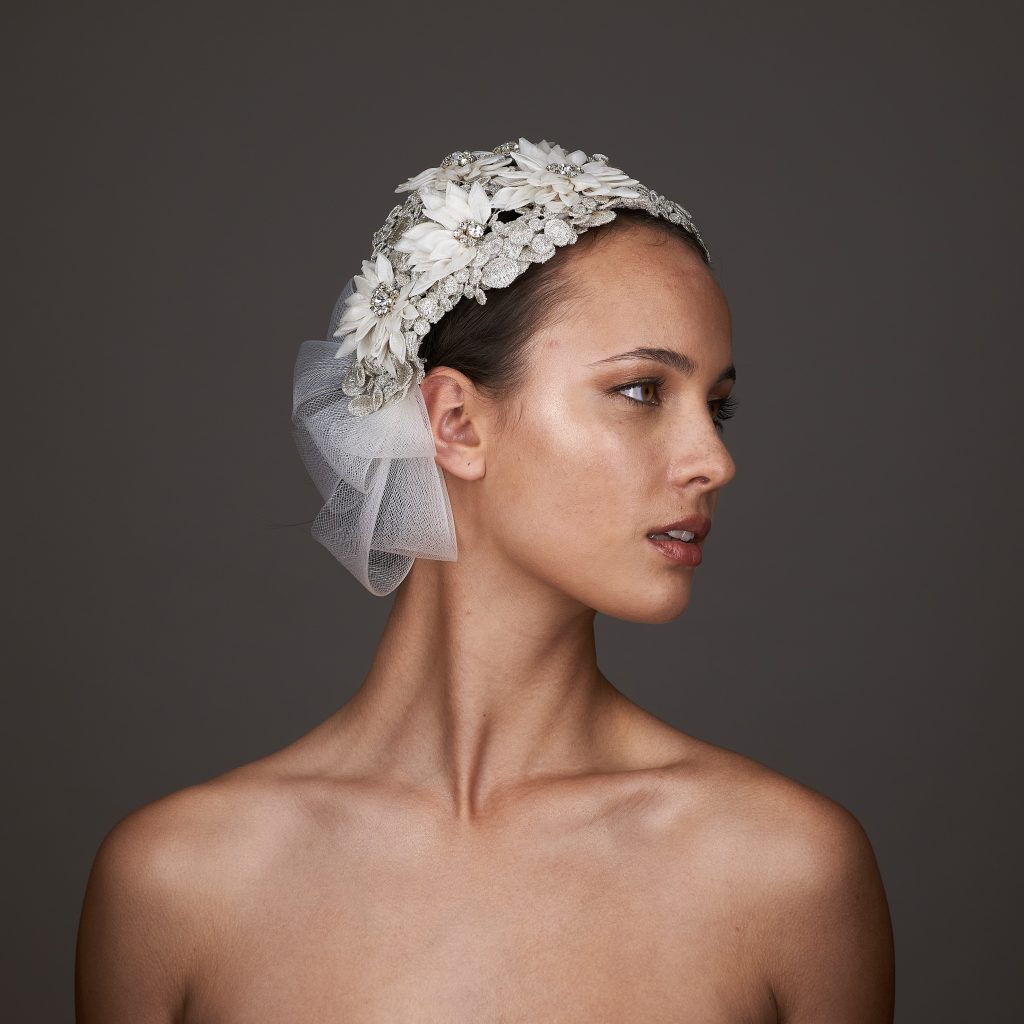
Leteisha Knecht
My inspiration is based on the 1920’s. The Gatsby years are always intriguing with the glitz and glamour of the lace, beading and fringing work, giving a feminine touch for the 1920s. I wanted to create an elegant and timeless piece for this theme.
Cynthia Jones-Bryson Millinery
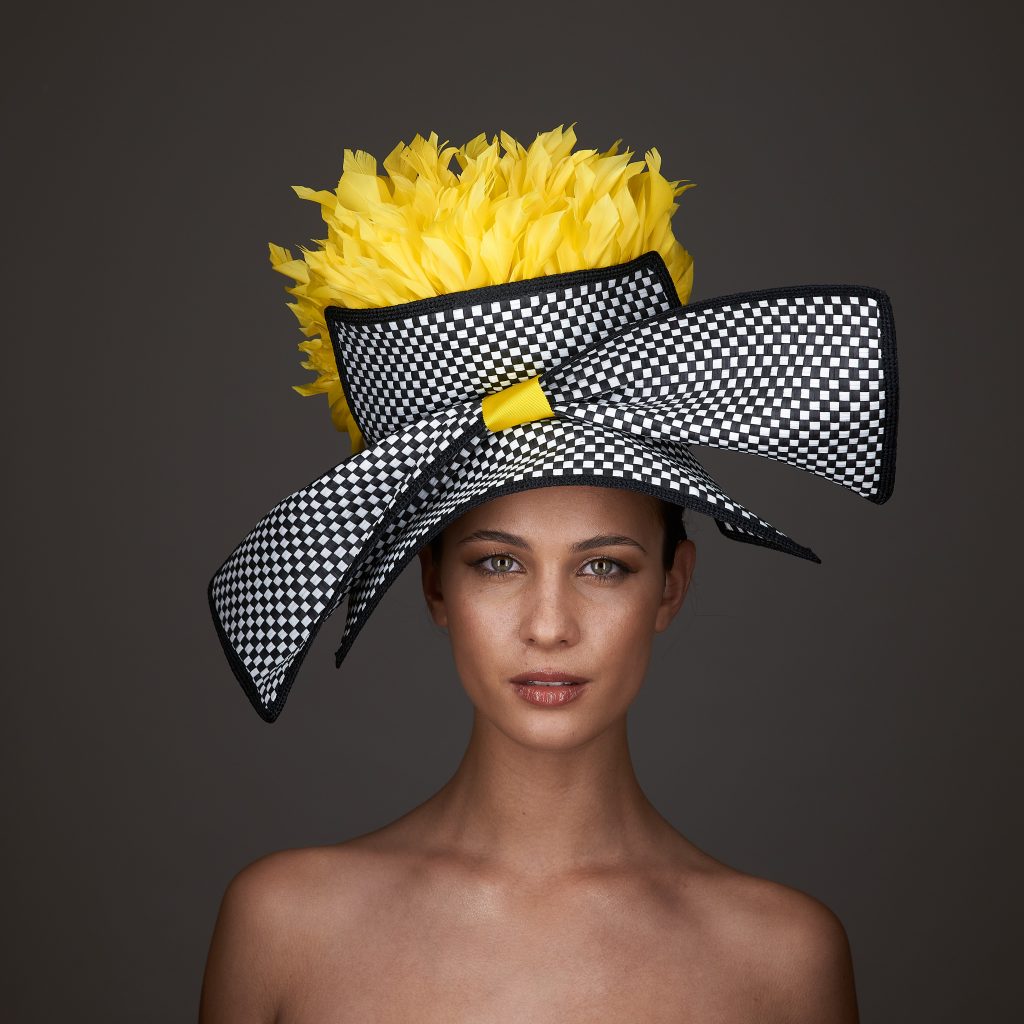
Cynthia Jones-Bryson ‘Move Over Jane Austen’
I was inspired by early 19th century bonnets and the idea of beautiful ringlets “peeking out from underneath it to complete the romantic picture”.
Somewhere Here
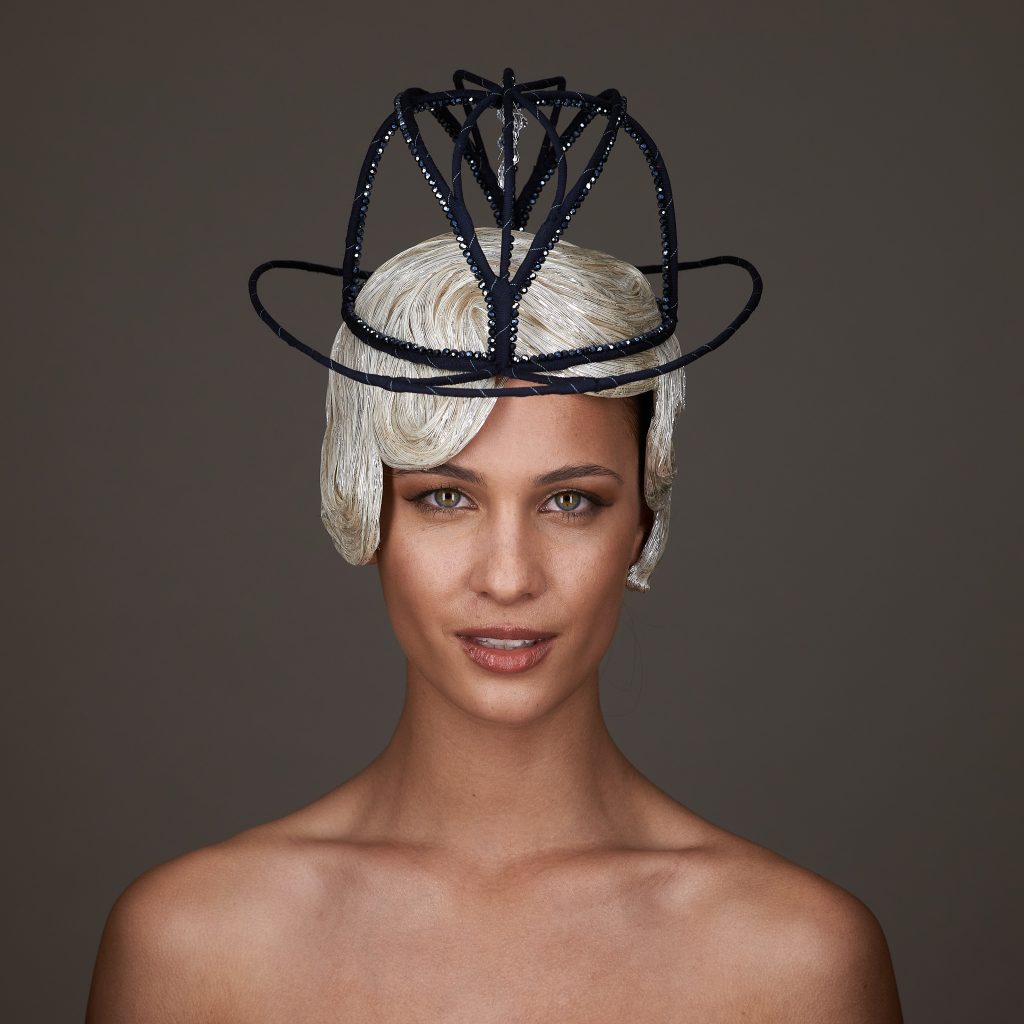
Andrea Cainero ‘Nein Gender Kabarett’
The heady ‘anything-goes’ years of Weimar Berlin are the stuff of legend. Bohemian nightlife, risque cabarets and an incredible flourishing of the arts had Berlin shine more brightly than any other city. Where sex, drugs and Kabarett embraced legal cross dressing and gender fluid performances, the Kabarett was a place to escape reality and be part of an underworld of fantasy and sensuality. My entry pays homage to the Berlin Kabarett of the 1920’s with a cloche style hat embellished with intricately undulating curves of silk abaca emulating popular ‘finger wave’ hairstyles of the era, then topped with a wire bowler to create a piece that references gender freedom of the time. The bowler has an Art Deco influence and is carefully covered in a navy and white pinstripe suiting, decorated with glass crystals but left bare between to show the fragility of society in that time where they walked the precipice between two devastating world wars. The exterior form of the hat symbolises the masculinity of the shape, but the inner beading juxtaposes this with a feminine cabaret influence. The mix of both men’s and women’s style influences are deliberate and a nod to the gender freedom of the period when cross dressing was legal, and celebrated within the entertainment world.
Zia Pazza Headwear
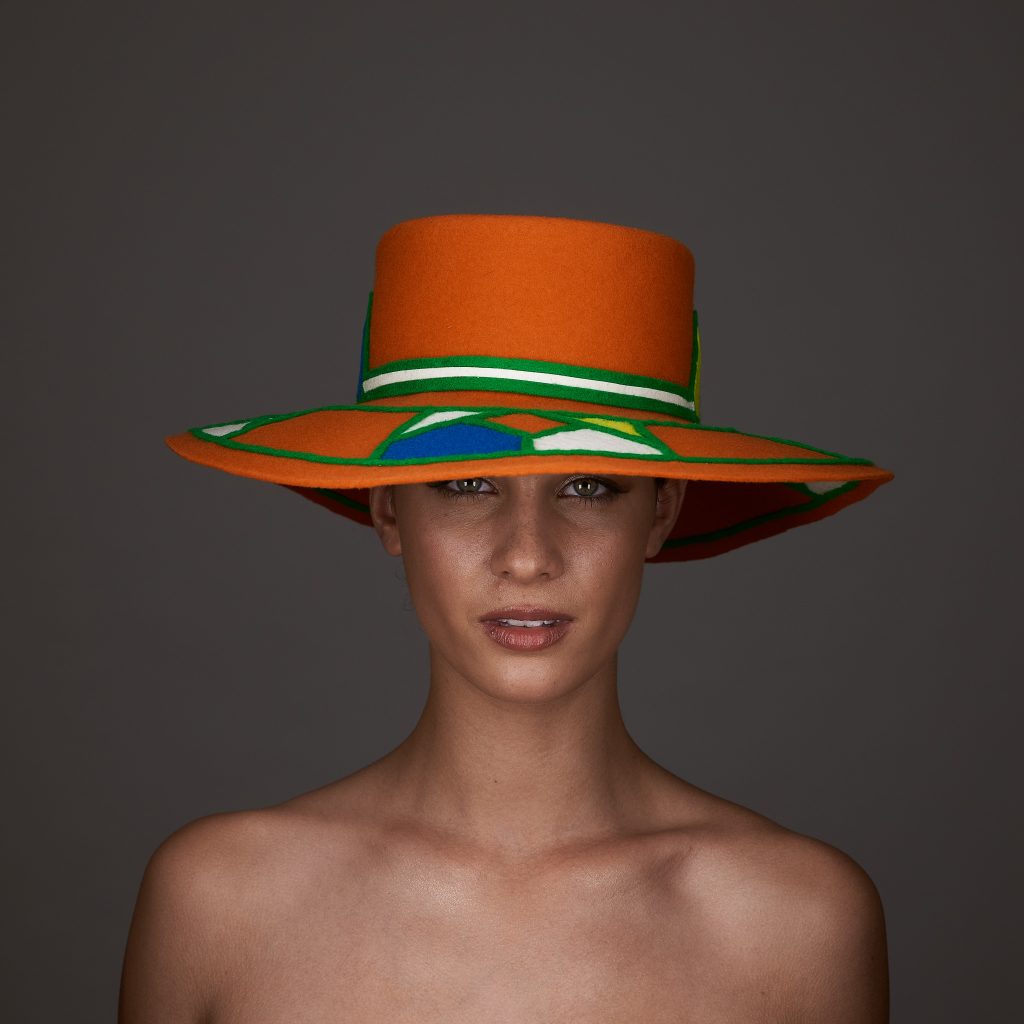
Lisette Margini
My Millinery Association Design Award entry was influenced by English ceramic artist, Clarice Cliff, and her ‘Bizarre Wear’ ceramics from the late 1920’s.
Christiana Moore
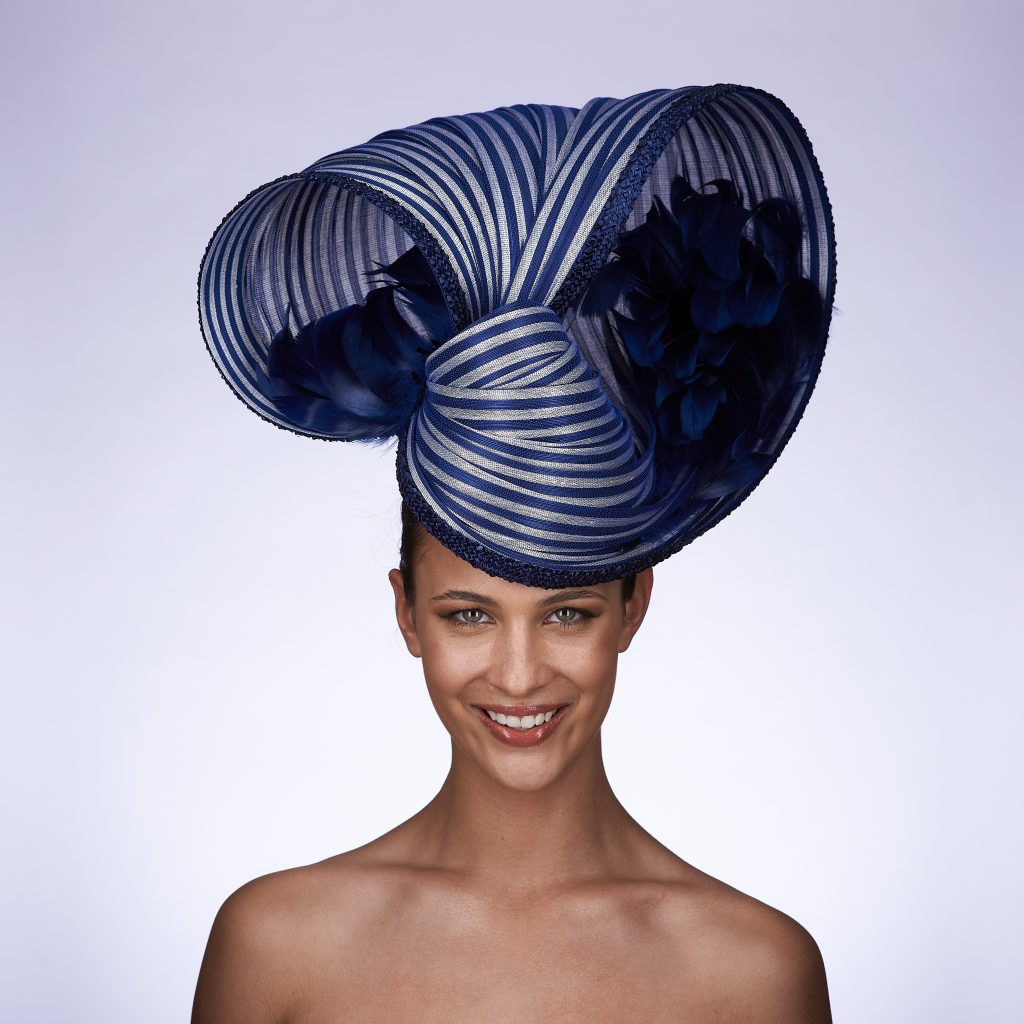
Christiana Moore
Inspired by the woodblock print ‘The Great Wave off Kanagawa’ created by Japanese artist Hokusai in circa 1820.
Christine Waring Millinery
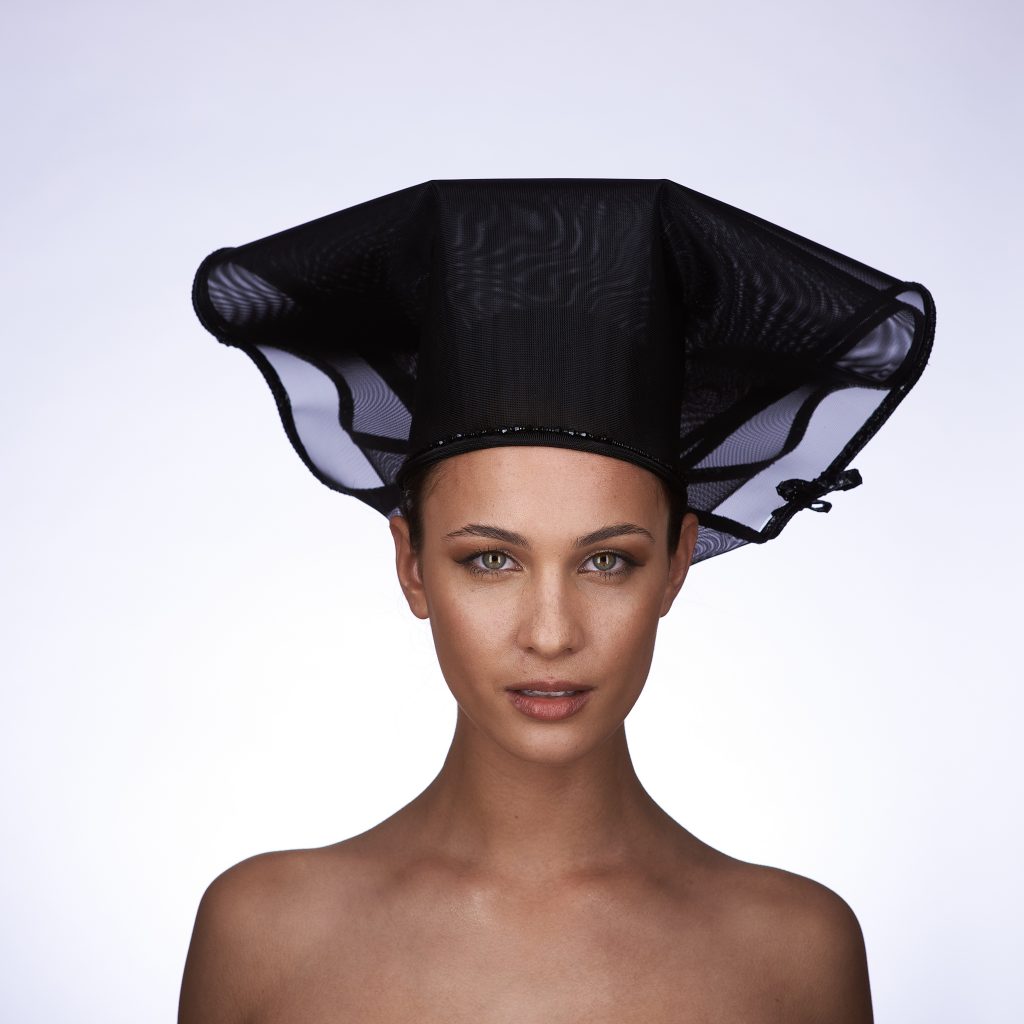
Christine Waring ‘The Headscarf Headpiece’
Throughout history the humble headscarf has been worn by women, usually out of practicality, but it wasn’t until the early 1920’s that this changed and it became a fashion accessory. French fashion houses began to add colour and embellishments to their designs as women were changing their lifestyles. “The Flapper” was born! My piece represents ‘the future’ and honours all women living in the 2020’s. The lightness and sparkle of the materials used are modern, strong and shiny, reflecting clear vision, strength and kindness of the 2020’s woman. Conservative or rebellious the headscarf is functional but always fun and it has endured the test of time!
Neil Grigg Millinery
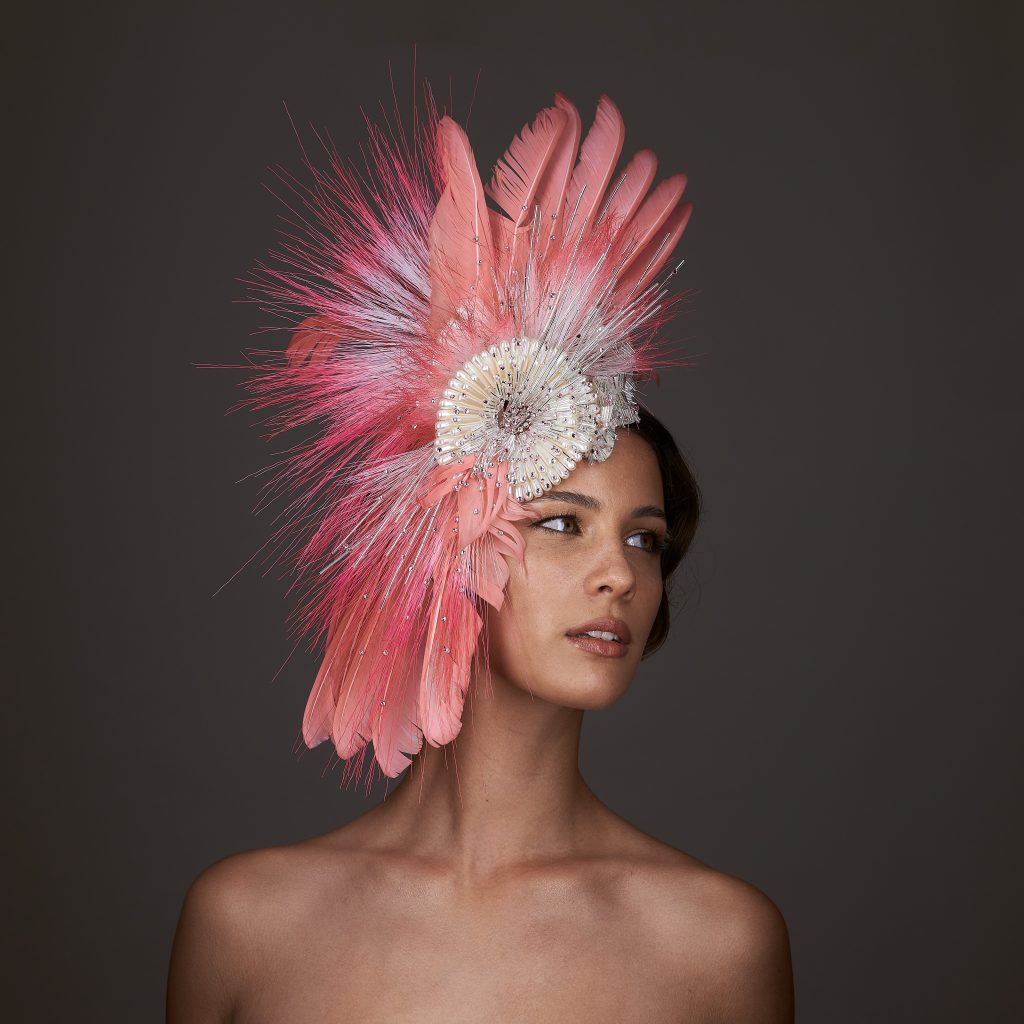
Neil Grigg
My headpiece found its inspiration firmly in the 1920’s, with a modern nod to the Melbourne Cup Carnival of today. The initial idea of a 1920’s headband, with a feathery and sparkly rosette and the Tivoli showgirls of the Roaring Twenties, was my design jumping off point. And of course my design award entry had to feature my signature ombré dyed feathers.
Delphine Nicholson Millinery
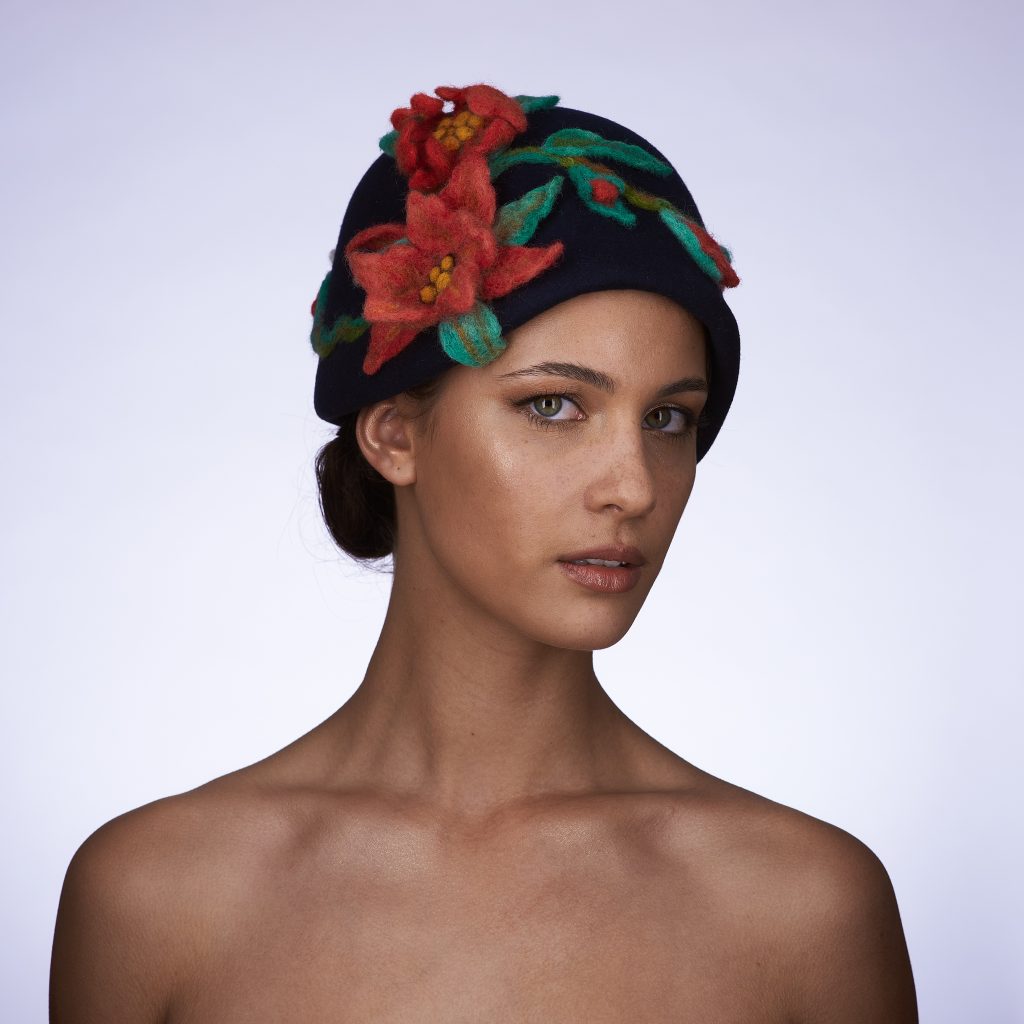
Delphine Nicholson
My newly acquired 1920’s vintage brimless cloche block deserved some pretty needle-felted flowers to brighten a winter’s day.
Millinery on Milner
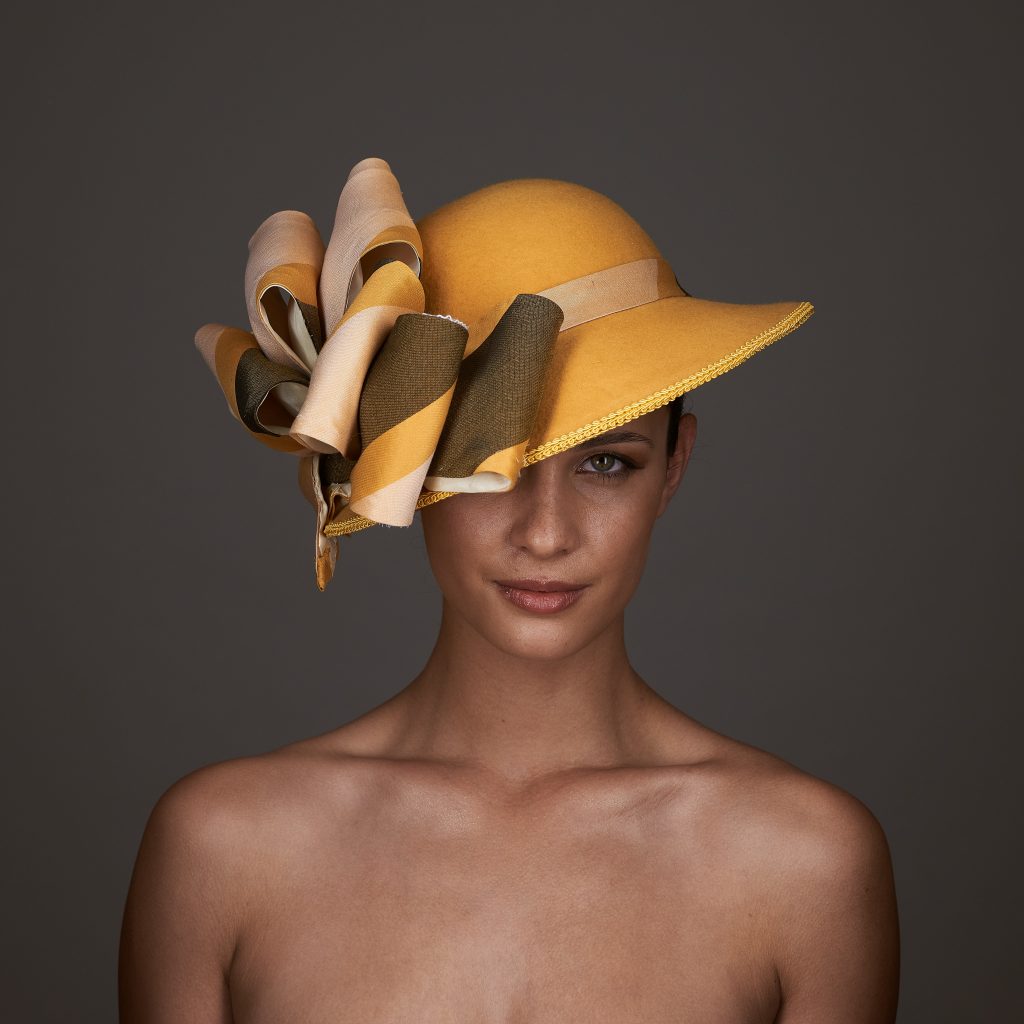
Mary Lyster-Robinson ‘The Cloche with the Most’
The 1920’s is almost my favourite era for its creativity and its innovations and styling. I have always loved the cloche hat.
Sandy F Hats & Headwear
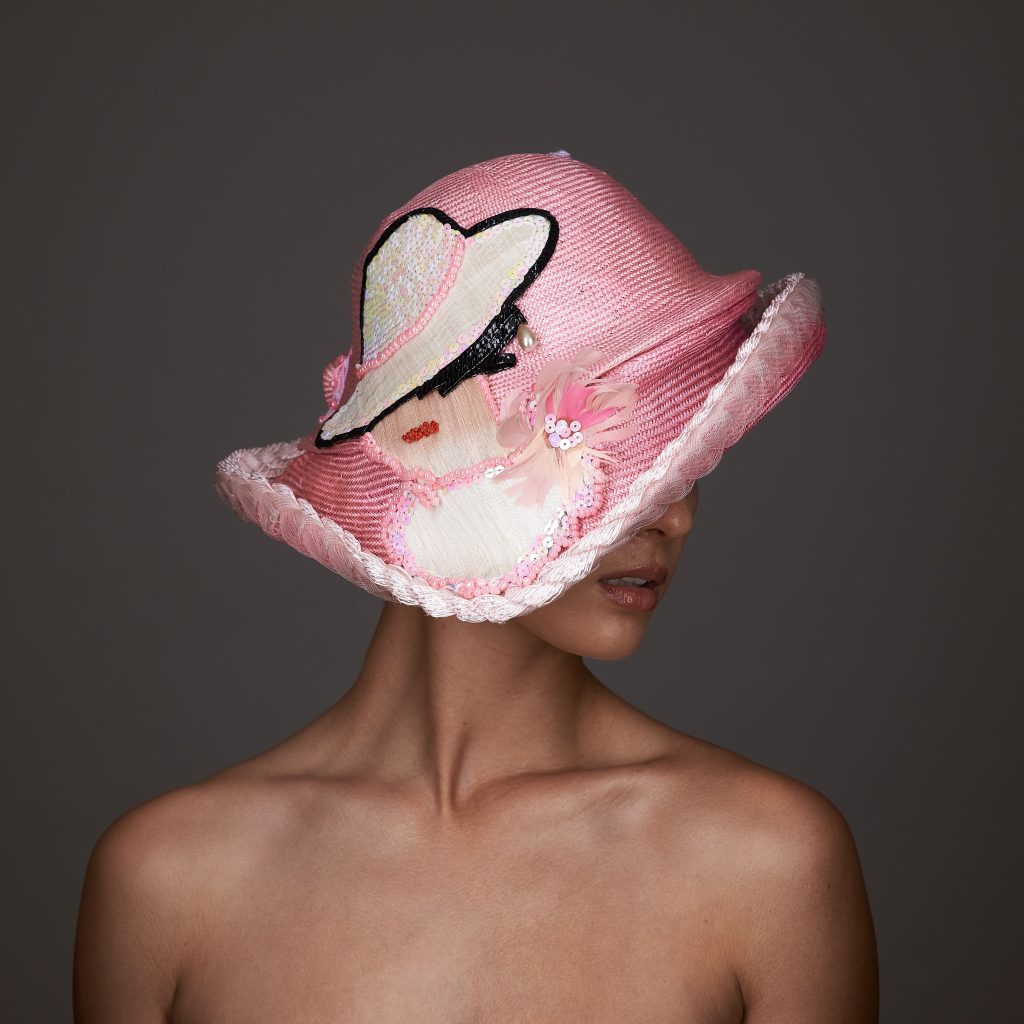
Sandra Forrester
Inspired by the thought of a 1920’s Garden Party at Ripponlea (a Victorian National Trust Property) where young flappers would gather to have fun.
Hats by Di Roberton
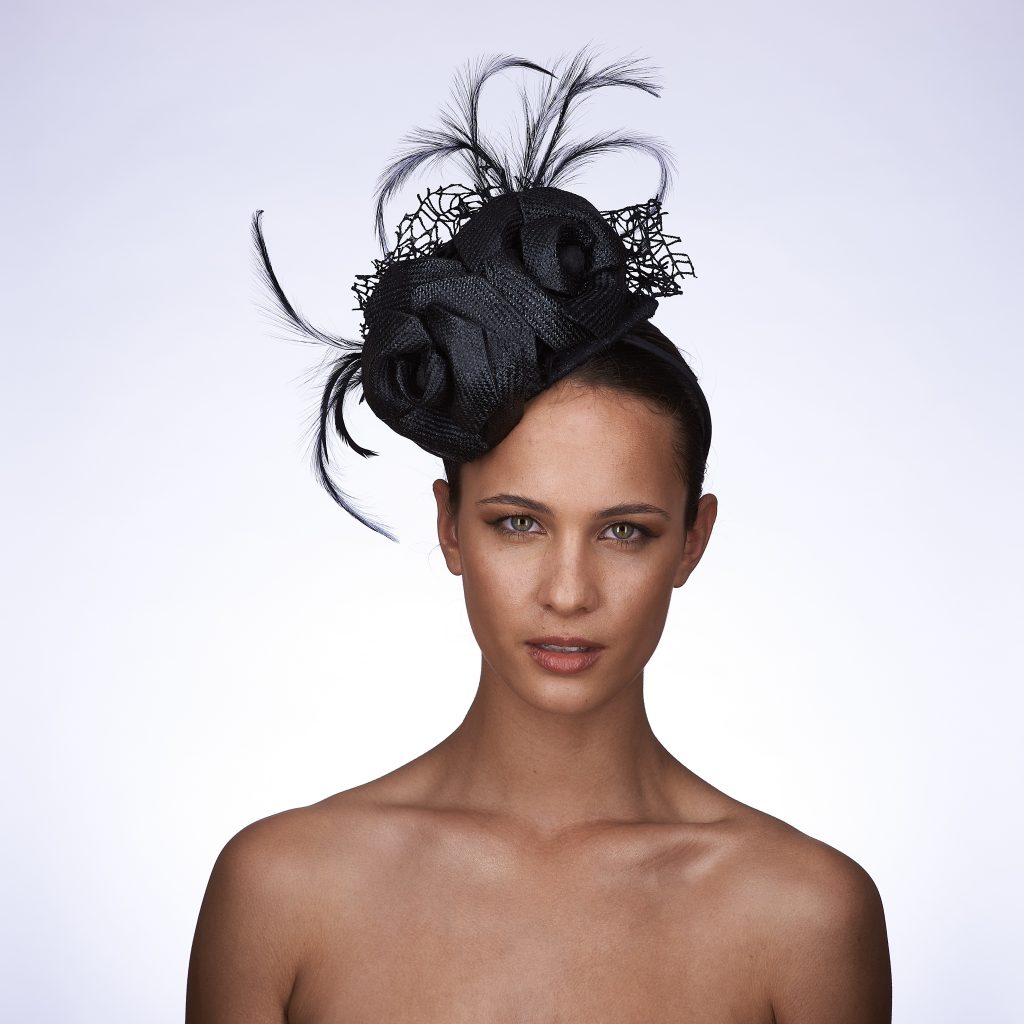
Dianne Roberton ‘The Rose’
My choice was 2020 for the Design Award. This headpiece has been worn in many different shapes and sizes for hundreds of years, with a vast array of adornments. I chose to feature the timeless rose.
FabHats by Oksana C
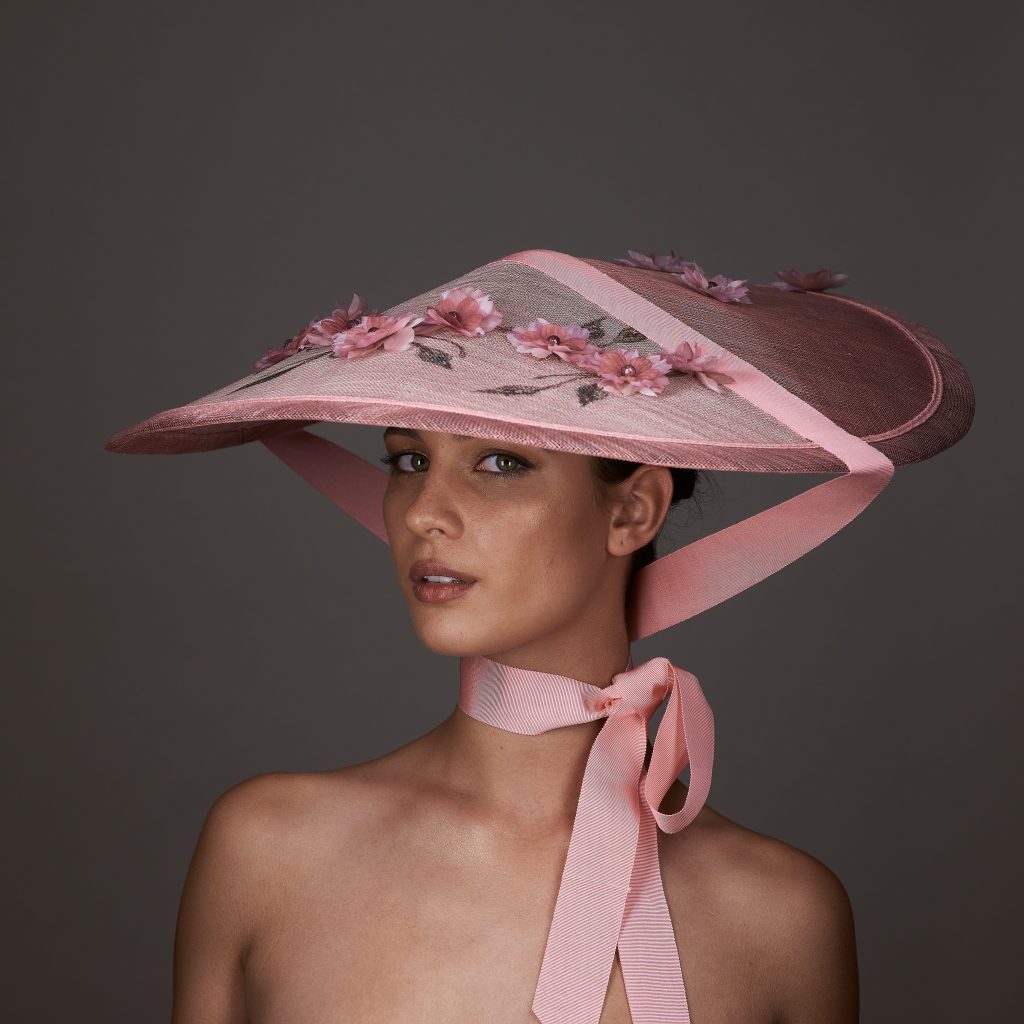
Oksana Caretti ‘Cherry Blossoms in the Wind’
My modern interpretation of the 1720’s French Bergere shepherdess hat. Cherry blossoms symbolize the fleetingness of life with the brevity of a blossom’s lifespan – merely two weeks every year. In Japan they are considered to be a symbol of good things to come and they serve as emblems for love and affection. In China, cherry blossoms symbolize female beauty and dominance.
Lisa Alexander Design
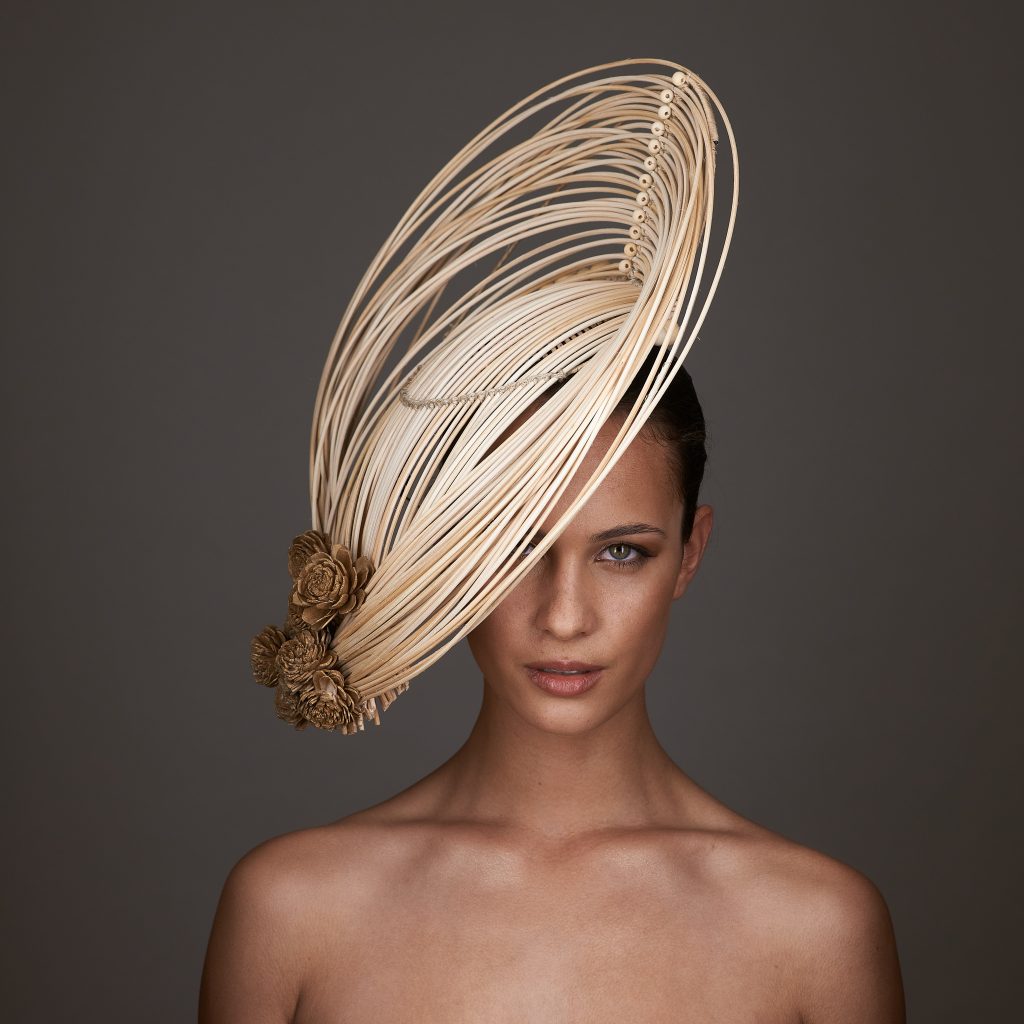
Lisa Bell
During 2020 I found time to contemplate and reflect. I love millinery – but I love it my way, which perhaps means that finding and experimenting with new materials is what appeals to me most. I still use important foundational millinery techniques that I was taught, but wanted to add my style which includes the use of ‘other’ or ‘less used’ materials. I think the 2020’s will be full of new materials and other ways of making hats. So my inspiration comes from that reflective moment with a nod into the future.
Rachael Henson Millinery
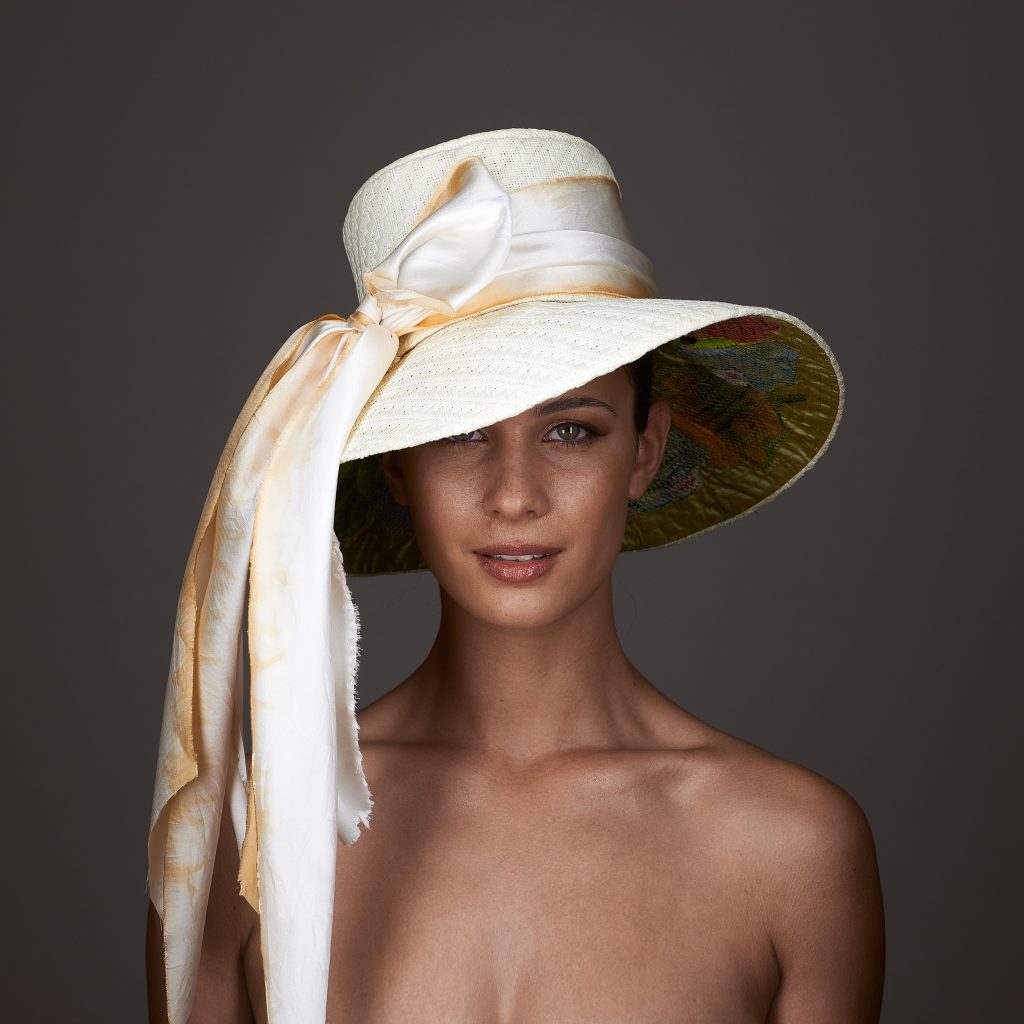
Rachael Henson ‘A New Looking Glass for Alice’
How will milliners interpret the world post pandemic? Fashion is undeniably affected; there’s an increasing casual approach to attire and hats which must reflect this to stay relevant and focus on sustainability. The crown and brim can be separated and interchanged with other brims and crowns for a completely different look. The trim is also negotiable – the silk tea dyed strip can be added or removed. This practicality also builds in potential return of customers to the post pandemic milliner, as clients seek to build on their combinations of brims, crowns and trims.
Wendy White Millinery
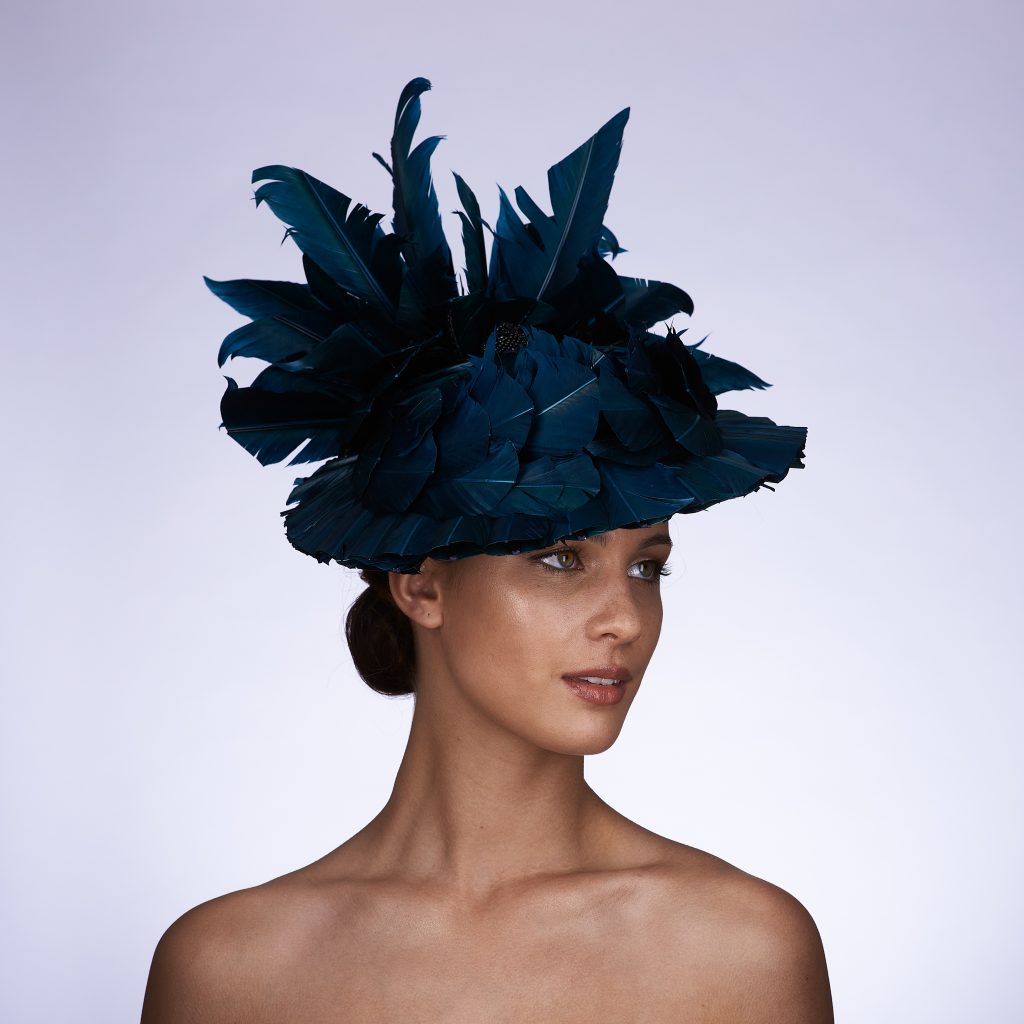
Wendy White
A twist on the 1920’s mens boater hat moved into the 2020’s with detailed feather work for the urban race scene.
Tammy Gill Design
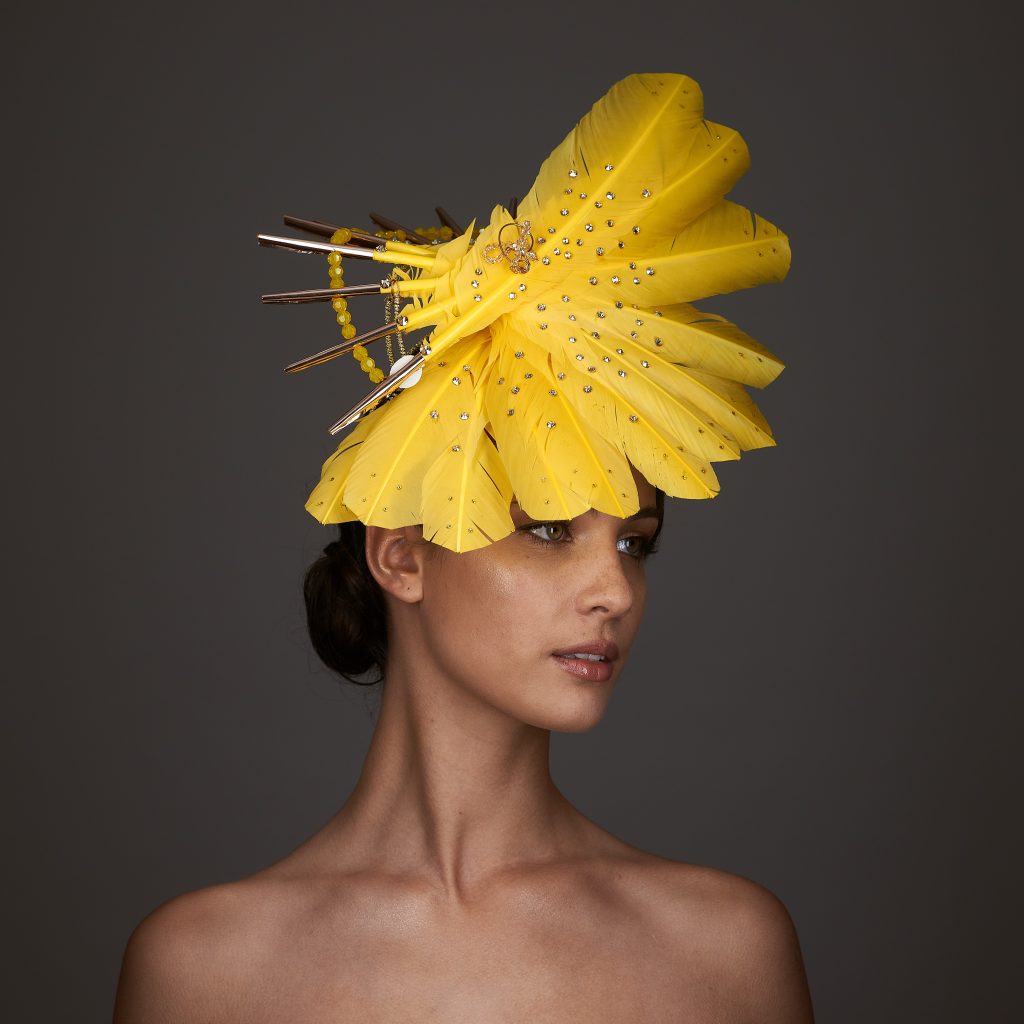
Tammy Gill ‘Hello Yellow’
I was inspired to capture the moment where 1920’s glitz meets today and tomorrow. My entry features Swarovski crystals, rose gold vinyl and an impressive fan of yellow feathers.
Chris Mullane Millinery

Chris Mullane
I wanted to create a modern piece inspired by the 1920’s. The headpiece is an abstract peacock design with Art Deco shaped feathers in classic black and gold. The gold metallic neck and head of the peacock is also a nod to the “Kiss Curl” hairstyle of that time.
Millinery Laa Laa
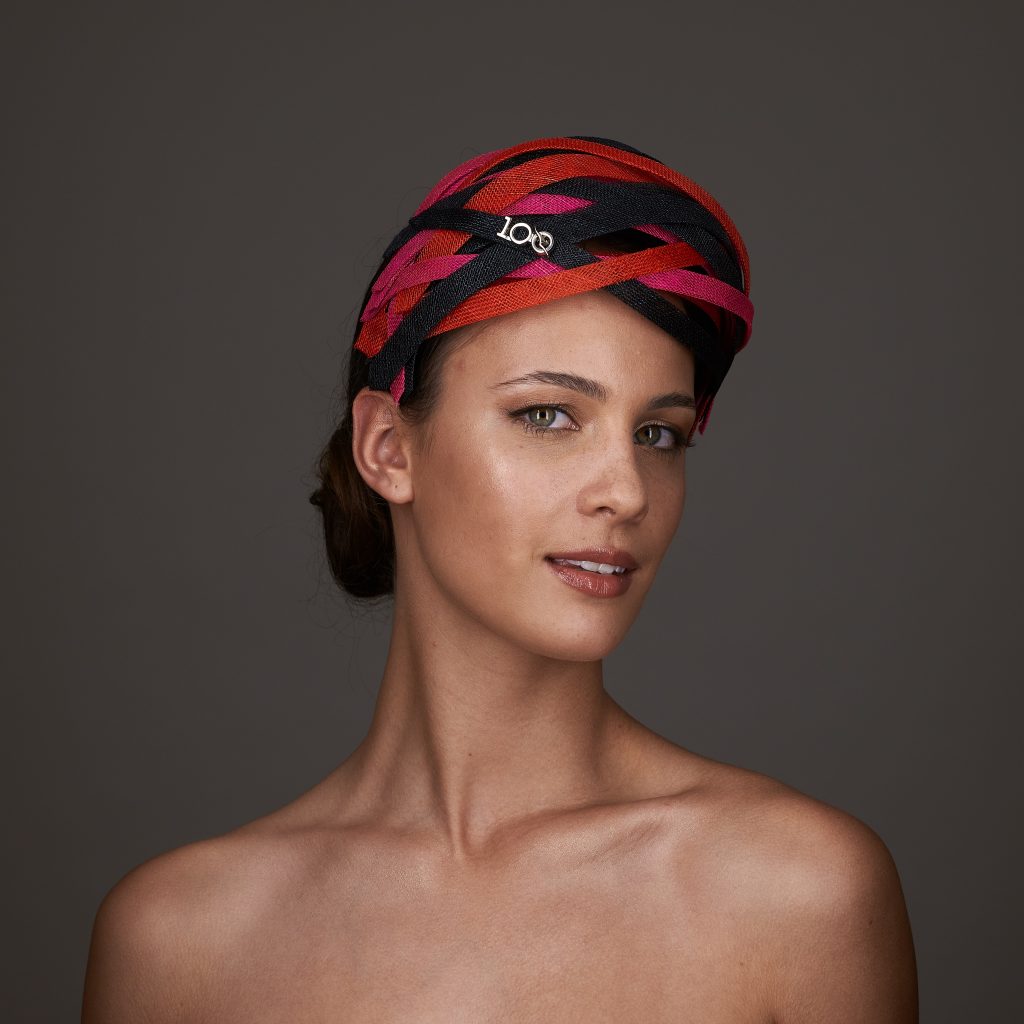
Fiona Cooper ‘Flying Kangaroo’
My entry is a festive celebration of Australia’s iconic Qantas airline’s 100 years of operation since its inception in 1920. The colours of my design are inspired by the crew’s uniforms over the years that reflect the Qantas logo. Sinamay has been formed into bands that cross over each other representing the flight paths taken by the ‘Flying Kangaroo’ (as seen on the maps in the inflight magazine) that criss-cross from city to city, both domestically and internationally.
Wendy Scully Millinery

Wendy Scully ‘Moet’
The cloche is iconic headwear of the 1920’s. The face hugging curved brim is the dominant feature of my entry as it shapes to the face in a fluid elegant double brim style headband. Vintage Japanese wedding Obi silk fabric is hand ruched and then beaded with clear Austrian crystals, which shimmer like bubbles of Champagne in the light. But, what will we wear in the future? In 2121? Plastics, recycled fabrics, paper? What style and shape of headwear will be made? Will we only wear sustainable based fabrics?
Image Credits
Event hosted by: The Millinery Association of Australia @millineryaustralia
Photographer: The Headshot Creative @leeknowlesphotographer
Model: Celeste Ryan @celeste.ryan
HMUA: Natasha Martin @natasha.nmstudio
Sponsors
Thank you to the following sponsors for their support of the competition: Hat Blocks Australia, The Total Package, SilkyFlora, Millinery.Info, Hatters Millinery Supplies, Millinery Hub, BUnique Millinery, House of Adorn, Hat Academy, The Hat Magazine, Hatlines Magazine, HATalk.
The display partners include Adelaide Arcade, Adelaide Hatters, Embellish Atelier and Brisbane Hatters and Avenells of Bundaberg.
Patron’s Pick was selected by The Millinery Association of Australia Patron Stephen Jones OBE

